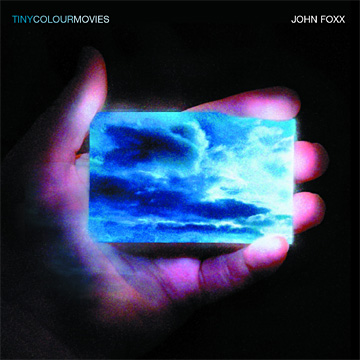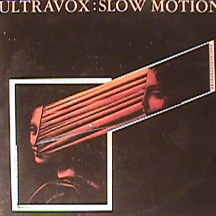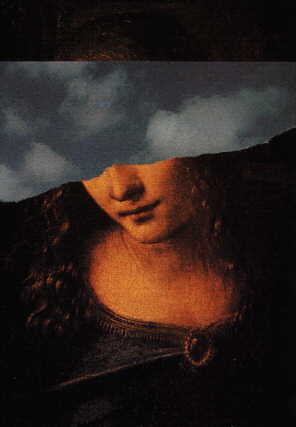‘old sunlight from other times and other lives’: John Foxx’s Tiny Colour Movies
Mon. June 19, 2006Categories: Abstract Dynamics

- He was in the market crowds, wearing a shabby brown suit. Trying to find me through all the years. My ghost coming home. How do you get home through all the years? No passport, no photo possible. No resemblance to anyone living or dead. Tenderly peering into windows
John Foxx’s latest LP, Tiny Colour Movies, is a welcome addition to this year’s rich cache of hauntological releases.
Foxx’s music has always had an intimate relationship with film. Like sound recording, photography – with its capturing of lost moments, its presentation of absences – has an inherently hauntological dimension. It wouldn’t be an exaggeration to say that Foxx’s entire musical career has been about relating the hauntology of the visual with the hauntology of sound, transposing the eerie calmness and stillness of photography and painting onto the passional agitation of rock.
In the case of Tiny Colour Movies, the relationship between the visual and the sonic is an explicit motivating factor. The inspiration for the album was the film collection of Arnold Weizcs-Bryant. Weicz-Bryant collects only films that are short – no movie in his collection is longer than eight minutes long – and that have been ‘made outside commercial consideration for the sheer pleasure of film. This category can include found film, the home movie, the repurposed movie fragment.’ The album emerged when, a few weeks after he attended a showing of some of Weicz-Bryant’s films in Baltimore, Foxx found himself unable to forget ‘the beauty and strangeness’ of Weicz-Byrant’s movies – ‘juxtapositions of underwater automobiles, the highways of Los Angeles, movies made from smoke and light, discarded surveillance footage from 1964 New York hotel rooms’ – so he decided ‘to give in to it – to see what would happen if [he] made a small collection of musical pieces using the memory of those Tiny Colour Movies.’
The result is Foxx’s most (un)timely LP since 1980’s Metamatic. Tiny Colour Movies fits right into the out of joint time of hauntology. Belbury Poly’s Jim Jupp cites Metamatic as a major touchstone, and time has bent so that the influence and the influenced now share an uncanny contemporaneity. Certainly, many of the tracks on Tiny Colour Movies – synthetic but oneiric, psychedelic but artificial – resemble Ghost Box releases. This is an electronic sound removed from the hustle and bustle of the Present. An obvious comparison for a track like the majestically mournful ‘Skyscraper’ would be Vangelis’ Blade Runner soundtrack, but, in the main, the synthetic textures are relieved from the pressure of signifying the Future. Instead, they evoke a timeless Now where the urgencies of the present have been suspended. Some of the best tracks – especially the closing quartet of ‘Shadow City’, ‘Interlude’, ‘Thought Experiment’ and ‘Hand Held Skies’ – are slivers of sheer atmosphere, delicate and slight. They are gateways to what heronbone used to call ‘slowtime’, a time of meditative detachment from the commotions of the current.
- I constantly feel a distant kind of longing. The longest song, the song of longing. I walk the same streets like a fading ghost. Flickering grey suit. The same avenues, squares, parks, collonades, like a ghost. Over the years I find places I can go through, some process of recognition. Remnants of other almost forgotten places. Always returning.
Tiny Colour Movies is a distillation of an aesthetic Foxx has dedicatedly explored since Ultravox’s Systems of Romance. Although Foxx is most associated with a future-shocked amnesiac catatonia (‘I used to remember/ now it’s all gone/ world war something/ we were somebody’s sons’), there has always been another trance-mode – more beatific and gently blissful, but no less impersonal or machinic – operative in Foxx’s sound, even on the McLuhanite Metamatic.

Psychedelia had explicitly emerged as a reference point on Systems of Romance (1978) – particularly on tracks such as ‘When You Walk Through Me’ and ‘Maximum Acceleration’, with their imagery of liquifying cities and melting time (‘locations change/ the angles change/ even the streets get re-arranged’). There might have been the occasional nod to the psychedelia of the past – ‘When You Walk Through Me’ stole the drum pattern from ‘Tomorrow Never Knows’ on, for instance – but Systems of Romance was remarkable for its attempt to repeat psychedelia ‘in-becoming’ rather than through plodding re-iteration. Foxx’s psychedelia was sober, clean-shaven, dressed in smartly anonymous Magritte suits; its locale, elegantly overgrown cities from the dreams of Wells, Delvaux and Ernst.
The reference to Delvaux and Ernst is not idle, since Foxx’s songs, like Ballard’s stories and novels, often seemed to take place inside Surrealist paintings. This is not only a matter of imagery, but also of mood and tone (or, catatone); there is a certain languor, a radically depersonalised serenity on loan from dreams here. ‘If anything,’ Ballard wrote in his 1966 essay on Surrealism, ‘Coming of the Unconscious’, ‘surrealist painting has one dominant characteristic: a glassy isolation, as if all the objects in its landscapes had been drained of their emotional associations, the accretions of sentiment and common usage.’ It’s not surprising that Surrealism should so often turn up as a reference in Psychedelia’s ‘derangement of the senses’.

The derangement in Foxx’s psychedelia has always been a gentle affair, disquieting in its very quietude. That is perhaps because the machinery of perceptual re-engineering seemed to be painting, photography and fiction more than drugs per se. One suspects that the psychotropic agent most active on/in Foxx’s sensibility is light. As he explained in this interview from 1983: ‘some people at certain times seem to have a light inside them, it’s just a feeling you get about someone, it’s kind of radiance – and it’s something that’s always intrigued me – it’s something I’ve covered before in songs like ‘Slow Motion’ and ‘When You Walk Through Me’. I like that feeling of calm….It’s like William Burroughs summed it up perfectly – ‘I had a feeling of stillness and wonder.”‘

There is a clear Gnostic dimension to this. For the Gnostics, the World was both heavy and dark, and you got a glimpse of the Outside through glimmers and shimmers (two recurrent words in Foxx’s vocabulary). Around the time of Systems of Romance, Foxx’s cover art shifted from harsh Warhol/Heartfield cut/paste towards gentle detournements of Renaissance paintings. What Foxx appeared to discover in Da Vinci and Boticelli is a Catholicism divested not only of pagan carnality but of the suffering figure of Christ, and returned to an impersonal Gnostic encounter with radiance and luminescence.
What is suppressed in postmodern culture is not the Dark but the Light side. We are far more comfortable with demons than angels. Whereas the demonic appears cool and sexy, the angelic is deemed to be embarrassing and sentimental. (Wim Wenders’ excruciatingly cloying and portentous Wings of Desire is perhaps the most spectacular failed contemporary attempt to render the angelic). Yet, as Rudolf Otto establishes in The Idea of the Holy, encounters with angels are as disturbing, traumatic and overwhelming as encounters with demons. After all, what could be more shattering, unassimilable and incomprehensible in our hyper-stressed, constantly disappointing and overstimulated lives, than the sensation of calm joy? Otto, a conservative Christian, argued that all religious experience has its roots in what is initially misrecognized as ‘daemonic dread’; he saw encounters with ghosts, similarly, as a perverted version of what the Christian person would experience religiously. But Otto’s account is a reterritorialization, an attempt to fit the abstract and traumatic encounter with ‘angels’ and ‘demons’ into a settled field of meaning.
Otto’s word for religious experience is the numinous. But perhaps we can rescue the numinous from the religious. Otto delineates many variants of the numinous; the most familiar to us now would be ‘spasms and convulsions’ leading to ‘the strangest excitements, to intoxicated frenzy, to transport, and to ecstasy’. But far more uncanny in the ultra-agitated, Dionysiac Present is that mode of the numinous which ‘come(s) sweeping like a gentle tide, pervading the mind with a tranquil mood of deepest worship.’ Foxx’s instrumental music – on Tiny Colour Movies and on the three Cathedral Oceans CDs, and with Harold Budd on the Transluscence and Drift Music LPs – has been eerily successful in rendering this alien tranquililty. On Transluscence in particular, where Budd’s limpid piano chords hang like dust subtly diffusing in sunlight, you can feel your nervous system slowing to a reptile placidity. This is not an inner but Outer calm; not a discovery of a cheap New Age ‘real’ Self , but a positive alienation, in which the cold pastoral freezing into a tableau is experienced as a release from identity.

Dun Scotus’ concept of the haecceity – the ‘here and now’ – seems particularly aposite here. Deleuze and Guattari seize upon this in A Thousand Plateaus as a depersonalized mode of individuation in which everything – the breath of the wind, the quality of the light – plays a part. A certain use of film – think, particularly, of the aching stillness in Kubrick and Tarkovsky – seems especially set up to attune us to hacceity; as does the polaroid, a capturing of a haecceity which is itself a haecceity.
The impersonal melancholy that Tiny Colour Movies produces is similar to the oddly wrenching affect you get from a site like Found Photos. It is precisely the decontextualized quality of these images, the fact that there is a discrepancy between the importance that the people in the photographs place upon what is happening and its complete irrelevance to us, which produces a charge that can be quietly overwhelming. Foxx wrote about this effect in his deeply moving short story, ‘The Quiet Man’ (Scanshifts and I used this at the start of our londonunderlondon broadcast last year). The figure is alone in a depopulated London, watching home movies made by people he never knew. ‘He was fascinated by all the tiny intimate details of these films, the jerky figures waving from seaside and garden at weddings and birthdays and baptisms, records of whole families and their pets growing and changing through the years.’
‘Here you see old sunlight from other times and other lives’, Foxx observes in his evocative sleeve notes for Tiny Colour Movies. To leaf through other people’s family photos, to see moments that were of intense emotional significance for them but which mean nothing to you, is, necessarily, to reflect on the times of high drama in your own life, and to achieve a kind of distance that is at once dispassionate and powerfully affecting. That is why the – beautifully, painfully – dilated moment in Tarkovsky’s Stalker where the camera lingers over talismanic objects that were once saturated with meaning, but are now saturated only with water is for me the most moving scene in cinema. It is as if we are seeing the urgencies of our lives through the eyes of an Alien-God. Otto claims that the sense of the numinous is associated with feelings of our own fundamental worthlessness, experienced with a ‘piercing acuteness [and] accompanied by the most uncompromising judgment of self-depreciation’. But, contrary to today’s dominant Ego Psychology, which hectors us into reinforcing our sense of self (all the better to ‘sell ourselves’), the awareness of our own Nothingness is of course a pre-requisite for a feeling of grace. There is a melancholy dimension to this grace precisely because it involves a radical distanciation from what is ordinarily most important to us.
- He stood in the soft beams of sunshine diffused by the curtains, caught for a moment in the stillness of the room, watching the dust swirling slowly golden through patches of light that fell across the carpets and furniture, feeling a strange closeness to the vanished woman. Being here and touching her possessions in the dusty intimacy of these rooms was like walking through her life, everything of her was here but for the physical presence, and in some ways that was the least important part of her for him.
Longing and aching are words that recur throughout Foxx’s work. ‘Blurred Girl’ from Metamatic – its lovers ‘standing close, never quite touching’ – would almost be the perfect Lacanian love song, in which the desired object is always approached, never attained, and what is enjoyed is suspension, deferral and circulation around the object, rather than possession of it – ‘are we running still? or are we standing still?’ On Tiny Colour Machines, as on Cathedral Oceans and the LPs with Budd, where there are no words, this feeling of enjoyable melancholy is rendered by the minimally disturbed stillness and barely perturbed poise of the sounds themselves.
- I can detect tiny edges of time leaking through. I feel nothing is completely separate. At some point everything leaks into everything else. The trick is in finding the places. They are slowly moving. Drifting. You can only do this accidentally. If you set out to do it deliberately you will always fail.
- It is only when you remember, only then will you realise that you caught a glimpse. While you were talking to someone, or thinking of something else. When your attention was diverted. Just a hint, a glimmer, a shade.
- Much later, you will remember. Without really knowing why. Vague peripheral sensations gather. Some fraction of a long rhythm is beginning to be recognised. The hidden frequencies and tides of the city. Geometry of coincidence.
Listening to Tiny Colour Movies, as with all of Foxx’s best records, one has a sense of returning to a dream-place. Foxx’s shifting or shadow city, with its Ernst-like ‘green arcades’ and de Chirico colonnades, is urban space as seen from the unconscious on a derrive; an intensive space in which elements of London, Rome, Florence and other, more secret places are given an oneiric consistency.
I lost myself in that city more than twenty years ago.

- Sleeping in cheap boarding houses. A ghost with leaves in his pocket and no address. The good face half blind. A nebula of songs and memories slipping in and out of focus. Someone told me he was there but it didn’t register at the time. The voice came unfocussed from all around. Still and quiet like the shadows of an ocean in the moving trees.
Indented text from the ‘Quiet Man’ story, ‘Shifting City’ and the Cathedral Oceans booklet.
STOP PRESS: I have just done a telephone interview with John Foxx, who was every bit as charming and fascinating as I’d expected… I’ll try and post that in the next few days…